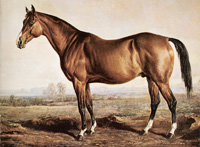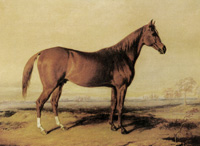 |
| Lexington (USA) |
 |
| Lexington (USA) |
 Lexington Sire Line  King Herod Sire  Boston |
Lexington b c 1850 (Boston - Alice Carneal, by Sarpedon). Sire Line King Herod. Family 12-b Jack of Diamonds Mare #1. Lexington was bred by Dr Elisha Warfield at The Meadows stud near Lexington, Kentucky. First named Darley because Dr Warfield fancied he bore a resemblance to the Darley Arabian, he made his eventful racing debut in the Association Stakes at the Spring Meeting in Lexington. Over a deep muddy track, young Darley, Madonna and Garret Davis ran off for two and three-quarter miles before being pulled up in a false start. With Garret Davis withdrawn, Darley distanced all but three colts in the first heat, and won the next two heats. That same week he won the Citizen Stakes, 2-mile heats, beaten in the first heat by Midway, then winning the next two. Darley was then purchased by Captain Willa Viley and Richard Ten Broeck who changed his name to Lexington. In a match against Sally Waters, 3-mile heats at New Orleans over the Metairie Course in deep mud, he won the first two heats, distancing the mare in the second heat. The Great State Stake of New Orleans, 4-mile heats, marked his first appearance as a four-year-old. Lexington (representing Kentucky) beat Highlander (Alabama), Arrow (Louisiana) and the undefeated Lecomte (Mississippi) over a muddy track, distancing Arrow in the first heat and favorite Highlander in the second. Only a week later he was defeated by Lecomte for the Jockey Club Purse, 4-mile heats in 7:26, 7:38 3/4, the fastest race to that point run in America. His jockey was blamed for his defeat, accused of pulling him up at the end of the third mile in the second heat, having lost track of the number of miles completed. Richard Ten Broeck, by this time in sole possession of Lexington, issued a challenge to Lecomte or any other for a match, 4-mile heats, or a run against the time of 7:26. The latter challenge was accepted and the five-year-old Lexington ran against time at the Metairie Course in April of 1855. In his first heat Lexington set times of 7:19 3/4, with the first mile in 1:47 1/4, the second mile in 1:52 1/4, the third mile in 1:51 1/2 and the final mile in 1:48 3/4. In doing so he beat the best time on record by 6 1/4 seconds. Less than two weeks later he beat his old rival Lecomte for the Jockey Club Purse, 4-mile heats, winning the first heat in 7:23 3/4 with Lecomte then withdrawn. Lexington's vision had been failing in one eye for some time, and now his other eye began to go as well (his sire Boston had gone blind), so America's greatest racehorse retired to stud, sound in wind and limb. He stood the remainder of the 1855 season at W F Harper's stud in Midway, Kentucky. In 1856 Robert A Alexander had gone to England to search for suitable stock for his new farm, Woodburn, near Midway. There he purchased Lexington from Richard Ten Broeck for $15,000, making Lexington the highest priced American horse to that time.
Lexington's stud career was equally remarkable - he would become the most successful stallion in history, Leading Sire sixteen times, fourteen times in succession. He sired such sons as Norfolk (b c 1861), the grandsire of Americus (or Rey Del Caredes, b c 1892) who was sent to England and sired Americus Girl (ch f 1905), the granddam of the flying filly Mumtaz Mahal (gr f 1921); undefeated Asteroid (b c 1861); the three brothers Kentucky (b c 1861), Daniel Boone (b c 1856) and Gilroy (b c 1862); Duke of Magenta (b c 1875) won Preakness Stakes and Belmont Stakes; Harry of the West (b c 1862); General Duke (ch c 1865) won Belmont Stakes; Shirley (b g 1873) won Preakness Stakes; King Lear (ch c 1863); Uncas (b c 1876) who sired Dunboyne (b c 1884) won Preakness Stakes; Harry Bassett (ch c 1868) won Belmont Stakes; the brothers Jack Malone (ch c 1855) and Pat Malloy (b c 1865) the latter the sire of Lord Murphy (b c 1876) who won the Kentucky Derby, and the grandsire of Manuel (b c 1896) also a Kentucky Derby winner; Hunter's Lexington (b c 1859); Vauxhall (b c 1865) sired Cloverbrook (ch c 1874) who won the Preakness Stakes and Belmont Stakes; Lever (b c 1863) sired Apollo (ch g 1879) who won the Kentucky Derby; Tom Ochiltree (b c 1872) won Preakness Stakes; and Kingfisher (b c 1867). His daughters were peerless, numbering among them Bay Flower (b f 1859) granddam of Bramble (b c 1875); Maiden (b f 1862) dam of Parole (b g 1873) who was sent to England and beat Isonomy; Nevada (b f 1869) dam of Luke Blackburn (b c 1877); Idlewild (b f 1859) dam of Wildidle (b c 1870); Susan Beane (ch f 1868) dam of Onondaga (ch c 1879), Sensation (br c 1877) and Stratford (br c 1873); Aerolite (ch f 1861) dam of Fellowcraft (ch c 1870), Rutherford (ch c 1871) and Spendthrift (ch c 1876), the latter the grandsire of Man o' War (ch c 1917); Hester (b f 1866) dam of Springbok (ch c 1870) won Belmont Stakes; Fanny Holton (b f 1862) dam of Ten Broeck (b c 1872); Madame Dudley (b f 1868) granddam of Olambala (ch c 1906); Florence (ch f 1869) dam of Hindoo (b.c. 1878) who won the Kentucky Derby; Kathleen (b f 1867) dam of George Kinney (b c 1880) who won the Belmont Stakes; La Henderson (b f 1865) dam of Vanguard (b c 1879) who won the Preakness Stakes; Mattie Gross (b f 1860) dam of Grenada (b c 1877) who won both the Preakness and the Belmont; Hira (ch f 1864) dam of Himyar (b c 1875); Sarong (ch f 1867) dam of Aristides (ch c1872) who won the first Kentucky Derby; Minnie Minor (b f 1860) the 4th dam of Durbar (b c 1911) who won the Epsom Derby; Lida (b f 1858) dam of Enquirer (b c 1867); and many more. A blood bay, Lexington stood 15.3 hands. He is described as a handsome horse with ideal conformation and possessed of an excellent disposition. Lexington died in the Woodburn stud in 1875. First interred in front of his consorts' barn at Woodburn, his skeleton was later exhumed and donated to the U.S. National Museum, now the Smithsonian Institution. It is now on permanent loan to the International Museum of the Horse at the Kentucky Horse Park. |
||||||||||||||||||||
|
|
|||||||||||||||||||||